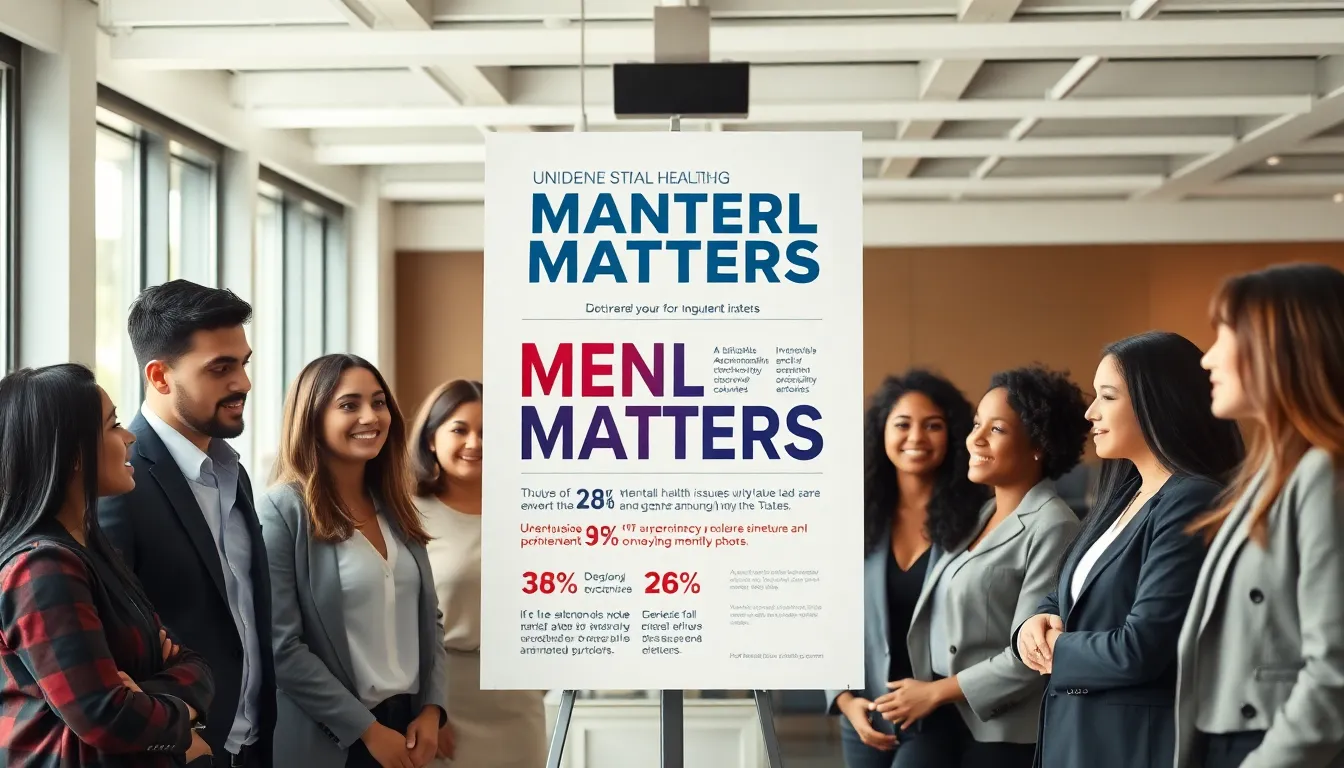In a world where mental health concerns are often overlooked, the importance of a compelling mental health matters poster cannot be overstated. Imagine a vibrant piece of art that not only catches the eye but also sparks conversations about mental well-being. It’s like motivational posters for the mind, powerful, persuasive, and essential in starting crucial dialogues. Jump into the colorful world of mental health awareness where every hue and message can uplift spirits and encourage change. This guide isn’t just another boring read: it’s your ticket to becoming a champion for mental health. So, buckle up.
Table of Contents
ToggleUnderstanding Mental Health

Mental health is a broad term encompassing emotional, psychological, and social well-being. It affects how individuals think, feel, and act. It also plays a critical role in determining how we handle stress, relate to others, and make decisions. A solid understanding of mental health is paramount, especially today when anxiety and depression rates are peaking, especially among younger populations. Over 50 million adults in the U.S. experience mental health issues each year, making awareness and understanding not just relevant but vital. Having a mental health matters poster can act as a catalyst in spreading knowledge. Posters can simplify complex topics, reduce stigma, and foster a more supportive environment.
The Importance of Mental Health Awareness
The importance of mental health awareness cannot be emphasized enough. Awareness is the first step towards understanding and, eventually, acceptance. Mental health isn’t just a personal issue: it’s a community concern. With mental health matters posters, communities can shine a spotlight on available resources, informing individuals about help they may not know exists. When these posters are displayed in schools, workplaces, or community centers, they create spaces where mental well-being is respected and valued. They serve as constant reminders that it’s okay not to be okay. By advocating for mental health, individuals can help dismantle long-standing stigmas, leading to a happier, healthier society. He or she who advocates becomes a beacon of light, illuminating the often dark journey many navigate.
Designing a Mental Health Matters Poster
Designing an effective mental health matters poster combines creativity with thoughtfulness. The visual aspect must grab attention without overwhelming the message.
Key Elements to Include
Start with a powerful slogan or message that resonates. Use short, impactful phrases that urge viewers to rethink their approach toward mental health. Incorporate contact information for local resources or hotlines, ensuring help is just a reach away. Also, images can take your poster to the next level, illustrating emotions or depicting community support. Including quotes from well-known figures or local leaders can lend credibility and inspire action. It’s also crucial to highlight inclusivity, making sure that all individuals feel represented.
Color Psychology in Mental Health Posters
Color plays an essential role in emotional response. Utilizing colors like blue can evoke calmness, while yellow may spark happiness. Green, often associated with harmony, can signify growth and recovery. Careful selection of hues can enhance the overall message, creating a comforting atmosphere that encourages individuals to engage with the poster’s content.
Incorporating Positive Messaging
Positive messaging is the heart and soul of any mental health matters poster. Emphasizing hope, resilience, and recovery sends a powerful message. Phrases like “It’s okay to ask for help” or “You are not alone” remind individuals they have the ability to reach out. This type of messaging not only fosters understanding but also encourages engagement. Adding local success stories or testimonials can personalize the message, thereby resonating more with the audience. By highlighting triumphs, communities can demonstrate the reality of overcoming challenges, encouraging others to envision their own journeys towards mental health.
Distribution and Community Engagement
To ensure maximum impact, distributing your mental health matters poster is crucial. Identify key locations within the community where individuals frequently gather, local cafes, libraries, schools, and healthcare facilities. Collaborating with schools to host mental health awareness weeks can also amplify distribution. Engaging the community in this try fosters a sense of ownership. Workshops or community meetings can be organized to explain the importance of mental health, making residents feel involved in the initiative. It can also be beneficial to host art contests centered around mental health themes, allowing local talent to design posters, creating a deeper community connection and awareness.
Evaluating the Impact of Mental Health Posters
Once a mental health matters poster is out in the wild, how can its impact be measured? Surveys can be an effective method to gauge community awareness and sentiment before and after the posters’ distribution. Organizations might track the number of individuals reaching out for help or accessing resources following the campaign. Monitoring social media engagement can reveal how well the message resonated with the audience. Partnering with mental health professionals to conduct focus groups can provide valuable qualitative data, exposing areas for improvement or further outreach. By evaluating these responses, communities can adjust their strategies, ensuring mental health initiatives continue to evolve and meet changing needs.



